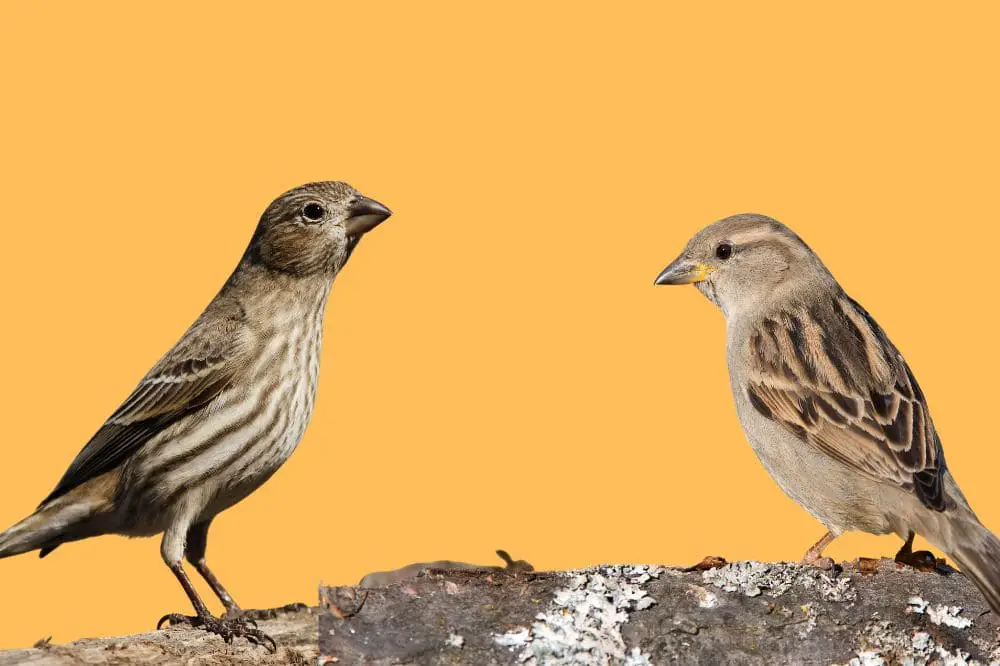Table Of Content

It probably also flies for longer periods of time than House Finches. No matter what kind of finches fly into your yard, you can persuade them to stay by providing shelter and black sunflower seeds. Don’t worry about misidentifying finches the first few times you see them. You really need to see Purple Finches and House Finches together at the same time for the differences to stand out. Additionally, the Purple Finch has a distinct white streak over her eye, a dark cheek patch, and a white stripe at the bottom of the cheek. House Finches typically begin breeding between March and August, with the female House Finch responsible for building the nests.

Related Field Notes
Purple Finches and House Finches do flock together, but not often. In some parts of their range, during the winter, Purple Finches and House Finches can occur together. The nest is usually 12 feet high, and she lays two to seven, pale blue eggs with purple speckling.
What are the differences in habitat and behavior between Purple Finches and House Finches?
It is now one of North America’s most widely distributed bird species. They can be found across most of the United States, southern Canada, and even parts of Mexico. Their adaptability has allowed them to thrive in urban and suburban environments.
Final Thoughts On Appreciation For These And Other Bird Species
They have, therefore, been excluded from regions where they used to be found in the past. While their plumage, habitats, and behaviors set them apart, both Finches share a common thread – the ability to captivate and adapt. Whether it’s the Purple Finch’s woodland serenade or the House Finch’s city groove, these feathered personalities contribute to the vibrant tapestry of North American biodiversity. The House Finch is native to western North America but has significantly expanded its range.
Songs And Calls
The Purple finch extends further north to parts of Canada, particularly western Canada’s Northwest Territories and Yukon. However, they also extend through Alberta, Ontario, Quebec, and Saskatchewan. House finches measure around 12.5 to 15cm (5 to 6in) in length, with a wingspan of around 20 to 25cm (8 to 10in). Purple finches measure around 12 to 16cm (4.7 to 6.3in) in length with a wingspan of around 22 to 26cm (8.7 to 10.2in).
10 Fun Facts about the House Finch Audubon - National Audubon Society
10 Fun Facts about the House Finch Audubon.
Posted: Tue, 21 Dec 2021 08:00:00 GMT [source]
This variation is due to the amount of carotenoid pigments they acquire through their diet. Some males are bright red all over their head, breast, back and rump, while other males have just small patches of dull orange in these areas. When it comes to identifying House and Purple Finches, it is important to take into account the range and habitat of each species as well as the size, bill, and coloration. House Finches generally consume a vegetarian diet consisting of vegetables, fruit, seeds, buds, berries, and small flowers.
Outdoors column: Timing's right for redbud blooms and purple finches - Chicago Tribune
Outdoors column: Timing's right for redbud blooms and purple finches.
Posted: Wed, 26 Apr 2023 07:00:00 GMT [source]
Both are of similar color, and both belong to the same genus Haemorhous. But, there are some telltale differences between these two birds if you know what to look for. The plumage color section really helps with males, but females are deciphered from their markings.
Female/immature Cassin's Finches have a browner face with less contrast between the brown "ear" patch and the white eyebrow and cheek stripes. In winter, found in a wider variety of habitats, including shrublands, old fields, forest edges, and backyards. Typically they leave Canadian breeding grounds to winter widely across the central and southeastern U.S, returning to specific regions roughly every other year. Often forages in the upper parts of trees eating mainly seeds and soft buds of evergreen trees and elms, tulip poplars, maples, and others. It would be tough to tell these birds apart on call alone as there is a good deal of crossover, and birds from different regions have slightly different songs. The House finch has the longer tail of the two birds, but they are otherwise similar.
Bill Shape
In flight, the House Finch looks daintier than the Purple Finch and looks like it has a smaller, more rounded head, and slightly longer tail. The main differences between House Finches and Purple Finches are the amount of red on the bird, and the pattern on the face. At first glance, both of these birds seem to have similar bills, but there are slight differences. A House Finch’s bill is shorter and the top is more drastically curved downward.
In the winter, they join flocks with pine siskins and goldfinches. House finches nest on the edges of open areas, sometimes on street lamps or in ivy on the sides of buildings. Purple finches nest primarily in forest conifers or dense shrubs, and at times in landscaped areas with trees.
Here are some important things to look out for when you see a small red finch in your backyard. Building alluring feeders for birds, particularly for finches, requires the determination of a decent area. The most ideal way to draw in finches to your feeders is to serve them sunflower seeds. In order to make identification between house finch vs purple finch, it is best to see both of the birds. When you see the differing features, it is easy for you to be able to spot the difference.
The Purple Finch acts in a similar fashion but is more a bird of forested habitats and doesn’t form flocks as large as the House Finch. It can also harass potential predators and is preyed on by various animals including squirrels, Blue Jays, Merlins, Sharp-shinned and Coopers Hawks, domestic cats, and other species. When a group of House finches finds a predator, they usually mob or harass the animal from a safe distance. They can do this to owls and hawks but, in desert habitats, are especially concerned with snakes, including the Western Diamondback Rattlesnake. The House Finch is a very social bird that forms pairs when breeding but flocks together at other times of the year.
Both female finches lack this colored plumage, but female Purple finches are heavily streaked with defined head markings, whereas female House finches are less streaky. It can also live in orchards, riparian zones, and parklands with conifers and ornamental trees. However, old male Purple Finches (those at least one year old) are always brightly colored across their head, breast and rump. The legendary birdwatcher and artist Roger Tory Peterson famously described them as ‘like a sparrow dipped in raspberry juice’!
These settings provide them with the dense vegetation and ample tree cover they prefer. When it comes to shape, the Purple Finch and House Finch exhibit subtle but distinguishable differences. The Purple Finch has a slightly larger and stockier appearance compared to the House Finch. The bill of the Purple Finch is slightly curved, giving it a more pointed appearance, particularly in males. “Is this new bird in my backyard a house finch or a purple finch,” asks Jim Gordon of Dassel, Minnesota. Before its expansion throughout the U.S., the house finch was native to the Southwest and was acclimated to an open, arid habitat.
In winter, the Purple Finch is particularly fond of sunflower seeds, while in summer its diet consists of fruits, seeds, and various insects, often attracted to feeders. Both species are attracted to bird feeders and enjoy sunflower seeds during the winter months. House Finches are typically active during daytime hours, not aggressive towards other birds, and often nest in close proximity.
During winter, they display a social nature, often gathering in flocks, whereas during the breeding season they become territorial and aggressive. House Finches are known to be social and non-territorial birds, often seen in flocks exhibiting hierarchical behavior, while Purple Finches tend to be solitary and territorial. Although the behavior of both species displays seasonal variation, there are notable distinctions between the two.

No comments:
Post a Comment